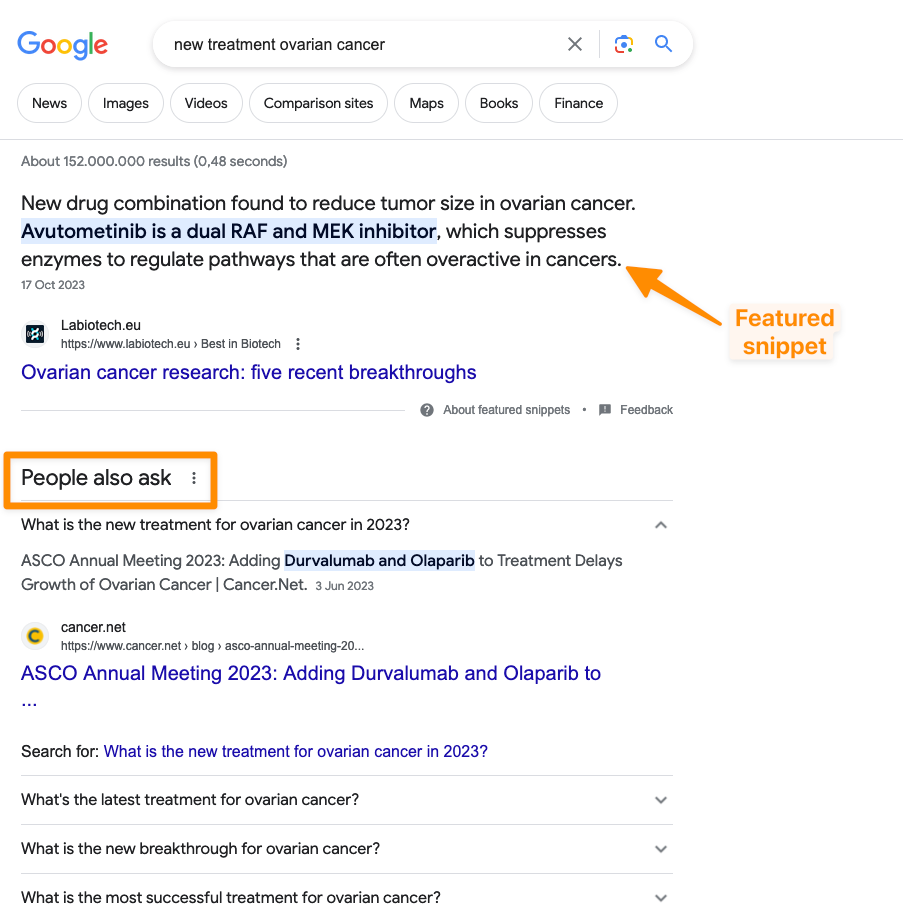Alright, listen up, my fellow science scribes.
I asked some subscribers what they wanted me to write about next, and one answer I get all the time is search engine optimization (SEO).
The dark magic of ranking on Google, right?
Well, here's the truth: shady backlinks and gaming the algorithm are a thing of the past.
Google's all grown up, and if you want your science-related content to shine, you've got to understand the game—intent is the name of the game.
So let’s explore that first.
Cracking the Intent Code
When you think about SEO, forget the technical mumbo jumbo.
SEO is easy to understand; all you have to do is put yourself in the shoes of your readers.
These days, content quality is king, which is why writers are at the forefront of the SEO game.
The Google algorithm has come a long way, and today it's all about figuring out what your readers want when they come to Google.
This is called their search intent.
Are they looking for information, trying to buy something, or just nerding out?
Tailor your content to that mood.
There are basically four types of search intent:
- Navigational: Users want to find a specific page (e.g., “PubMed login”)
- Informational: Users want to learn more about something (e.g., “what is particle physics”)
- Commercial: Users want to do research before making a purchase decision (e.g., “best lab coats”)
- Transactional: Users want to complete a specific action, usually a purchase (e.g., “buy new sneakers”)
In the case of science writers (or any kind of scientific writing), informational intent should be the most relevant because it's mostly how people search for articles to read online.
Search intent affects the results Google is spilling out.
Let’s say you want to write about particle physics.
There are many searches that could be associated with it, like:
- What’s particle physics?
- Which industry uses particle physics?
- What companies are working on particle physics?
- What are the real-world applications of particle physics?
As you can see, the search intent behind all of these questions is related to particle physics, but they all have a specific answer based on that intent.
If you take the question, "What companies are working on particle physics?", you are most likely looking at someone with a business-related intent, probably with some idea of what particle physics already is, and therefore perhaps even someone interested in selling to particle physics companies.
Their intent will be very different from someone who is just typing "What is particle physics?”
Basically, you have to know your audience to rank well on Google.
Intent dictates the game.
So, before you start typing away, ask yourself: Who am I writing for? What are they searching for? Are they just browsing or ready to pull out their credit card?
When you publish something, Google’s crawlers (bots that constantly scan the web) will check the page.
Then the page is presented to some users who are searching for related things.
If users tend to click on your article more than others and tend to stay on the page (this is extremely important), then Google will rank it higher and you may end up with the prestigious first search result (which basically drives most of the traffic related to a search).
As a science writer, that's what you need to know about how Google fundamentally works.
But knowing the intent is one thing, knowing what to write about is another.
And that's where keyword research comes in.
Nailing Keyword Research
As emphasized earlier, grasping the reader's intention is the key to creating content that climbs the Google ranking ladder.
The keyword serves as a succinct encapsulation of this intent, distilled into a few choice words.
Researching the keyword volume (the traffic they might generate) is a good way to help you choose what to write about.
Now, let's quickly run through the basic tools at your disposal:
- Google Search: The obvious place to begin. Start typing anything into that Google bar, and voila! Instant recommendations. These are your clues to what's buzzing in the search realm.
- Google Trends: This one's your high-level insight into a keyword's trendiness. It won't spill traffic estimates but gives you a sense of how hot the keyword is compared to previous periods. Great for seasonal and news-related content, not so much for everyday businesses.
- SEO tools (SEMrush / Ahref): The heavy artillery in your SEO arsenal. These tools unveil the nitty-gritty details, akin to having a spy infiltrate your competitor's workplace. Bear in mind, though, they come with a hefty price tag and are not user-friendly. If you're pinching pennies, Ubersuggest, a free tool from the SEO maestro Neil Patel, is a solid alternative.
- Google Search Console: Consider this your home base for all things SEO on your site. If your website is plugged into Google Analytics, the Search Console becomes your command center. It tells you how your content is ranking. Got some low-hanging fruits waiting to be optimized? Dive into the insights from here. It's not just a ranking oracle; it doubles as a technical audit for your website. The warning signals it sends about issues Google crawlers might bump into are priceless. Fix 'em, and watch your ranking soar.
And now, in this AI-dominated era, you can even enlist the help of ChatGPT to turbocharge your keyword search.
For a deep dive into the world of keyword research (which could take a full-length article on its own), check out this excellent resource at WTF is SEO.
Also, keep in mind that there are two major types of keywords: short-tail and long-tail keywords.
A short-tail keyword is a high-level search composed of one or two keywords, while a long-tail means the search gets more precise and uses more words.
For example, “particle physics” is short-tail, while “particle physics startups in Europe” is long-tail.
Now remember, ranking for short-tail keywords is extremely difficult, especially if your site doesn't have a lot of authority (we'll explore what that means later).
So your best chance is almost always to target long-tail keywords, which also have a clearer search intent, thus supporting the strategy I explored above.
Ok, so now you know how people search and where to find interesting things to write about.
Now let's see what you can do on the article page to boost your rankings.
Rocking On-Page Optimization
On-page SEO is basically what you can control as a writer.
It’s everything that’s related to the content, as opposed to technical SEO, which focuses on the technical aspect of your website, and off-page SEO, which focuses on building external links that point to your website.
Getting on-page SEO right will do most of the groundwork, so it’s primordial that you understand what you’re doing.
Let's break down the six parameters that can level up your on-page SEO game:
1/ Headline
The headline is arguably the most important part of any article when it comes to SEO.
Why is that?
It's the gatekeeper, determining whether readers click to delve deeper or scroll past obliviously.
Crafting the perfect headline involves using engaging words, maintaining a clear structure, and, most crucially, avoiding false promises.
Google isn't fooled by clickbait; deliver on your headline's promise.
Remember, if your initial headline falls short, don't hesitate to experiment with a new one and republish.
The era of static print is over; online articles can evolve until they serve their purpose.
2/ Subheadings
Subheadings act as your readers' guides, providing digestible sections and a semblance of organization to your writing.
Subheadings should follow a strict hierarchy so that Google can easily follow the outline of your page.
Your article’s headline is what’s called an H1 (because in the HTML code, the title is between <h1> tags) and is the highest level of organization.
Your page should only have one H1 on the page (otherwise, you will be penalized).
Then comes the first level of subheadings, the H2.
Under an H2, you can have several H3, and under an H3, several H4, and so on.
While H5 and lower sublevels are possible, it's wise to avoid going any further to avoid messy indentations.
Optimize subheadings for humans, not just algorithms.
Clear, engaging subheadings keep readers glued to your article till the end, and that counts for a lot in your SEO rankings.
3/ Metadata (Meta Title and Meta Description)
Metadata, the SEO trick up your sleeve, lets you fine-tune your article's title and description for Google searches.
In many modern CMS (Content Management Systems, such as WordPress), if you don’t do anything, the system will take the first paragraph of your article and fill in the meta description with it.
You don’t want that.
Instead, you want to craft your own version that fits the character limit.
The meta title is basically the blue text you see on Google, and the meta description is the block of text that goes below:

Always rewrite your article title within the 60-character limit to avoid being truncated in search results.
The meta description deserves the same attention.
Write a compelling, concise description under 155 characters to optimize conversion rates in search results.
Make sure your meta title matches the content of your article, otherwise people may leave early and you will be penalized.
4/ URL
Take a look at your URL before you publish.
Rule number one: keep it short, with only essential keywords.
Ditch unnecessary words like "and," "the," or "or."
For lengthy titles, stick to 2-3 keywords.
So if you are writing something like “The complete history of lab coats and their usage in academic research,” change your URL to www.yoursite.com/lab-coat-history.
Steer clear of using dates in URLs; it's SEO kryptonite.
Imagine you want to update your content the next year and change the date in the URL; you’ll break your link and lose all the precious SEO juice you’ve built up so far.
Get the URL right the first time, because changing a URL after the fact is the worst thing you can do in SEO.
5/ Internal links
This is by far the most underrated aspect of SEO.
Many journalists get it wrong.
Internal links are the fuel for your SEO engine.
Each article should link to other relevant pieces on your website.
Aim for 5 to 10 in-text internal links per story.
Link meaningfully, using sentences rather than single words.
You can also use formulations like “Read more” or “See also” to add links.
After a while, you'll notice that some pages (usually those that cover broader topics) have more links than others.
In SEO, we call these pillar pages, and they are the biggest traffic drivers.
Once you have a pillar page, a safe and sound strategy to increase your rankings is to write articles that target related long-tail keywords.
Your pillar will basically support all those long-tail and vice versa, fostering a cohesive content network on your website that Google will regard as quality.
6/ Images
Images aren't mere page decorations; they're storytelling tools requiring their own SEO optimization.
Your images should be placed contextually on the page, not just at random positions.
They should be supporting the nearest paragraph in a coherent way.
Choose unique images over stock photos and stick to standard formats (JPEG, PNG, GIF, BMP, WebP, SVG).
Compress image file sizes using online tools or leverage a CMS that does it automatically for you (like Ghost, one of my favorite tools).
Every image needs an alt text explaining its content, and if you add captions, make sure to add relevant information and avoid generic filler.
The filename of your image should also explain what you’re trying to show.
So avoid img3894.png and use room-temperature-superconductor.png (and never use underscores in your image name).
These are the 6 parameters you can play with right now to make sure your article is ready for prime time.
But since the introduction of the EEAT algorithm, ranking on Google has become a long-term game.
Let’s explore how it works.
Decoding the EEAT Algorithm
EEAT stands for Experience, Expertise, Authoritativeness, and Trustworthiness.
It’s basically the parameters Google considers for “creating helpful, reliable, people-first content.”
I won’t go over the details of how we ended up with this algorithm because other people are explaining it better than I can, but you basically need to know that since 2014, Google has made big efforts to ensure that quality content wins the day.
So I’ll give you an extra quick overview of what these terms mean to give you a better idea of what Google understands by “quality,” but if you want more details, I’ll point you to this great article from WTF is SEO.
Let’s break it down:
- Experience: Share your personal experiences. Use sentences that reflect first-hand experience (“When I did this…”). Google loves a personal touch.
- Expertise: Show, don't just tell. Drop some photos, and spill the beans on how you got those results. This is where your choice of a clear niche will be an advantage. Your author page is also becoming increasingly important in SEO, so make sure it reflects your expertise.
- Authoritativeness: This is the reputation of your publication. The more reputable your site is, the easier it is for your articles to rank. Authority is mostly measured by backlinks (note: the quality of the backlinks is also important; don't try to cheat with a lot of low-quality links). Social media also counts as backlinks, so if people engage with your content, your authority will increase.
- Trustworthiness: This includes 2 aspects. First, the transparency of your article. Lay out your research methods and disclose your sources. Then, you also need a legitimate website that doesn’t look fishy. So if you have payment options, make sure you use a trusted provider.
If you followed my explanation of search intent, you should already be armed to create EEAT content.
At the end of the day, this is all very obscure, and nobody really knows how this works anyway.
What we do know is that human-centered content created with purpose and expertise wins over everything else.
So keep that in mind when you write about science, and you should not have much trouble ranking.
Riding the New Google Features Wave
You may have noticed that when you ask a question on Google, you often get a big box with the answer.
This is called the feature snippet, and it is very powerful in SEO.

A good strategy for getting featured is to look at the current answer to a question and try to develop a more qualitative answer (for example, using the EAAT template we've seen above).
If a question is not answered at all, you may have an even better chance of getting featured.
The feature snippet is also used in the “People also ask” section just below.
Again, producing a good, short answer to a question is the best way to get shown here.
Of course, the rest of your article needs to be great, too, so don't start making extra short pages and hoping they'll be featured.
It doesn’t work like that.
Finally, keep in mind that AI, namely Bard, is coming to Google search.
Soon, people may skip the search altogether and just rely on the AI's answer.
This can be seen as a threat to journalism as we know it, or an opportunity to drive even more traffic to great stories.
Remember, when people want to dive deep into a topic, chatting with an AI isn't going to cut it.
So they will always try to go to the best source possible.
And if you create great content, even the AI will recommend it.
Technical SEO? Nah, Not Your Problem
You're a science writer, not a tech guru.
My advice is not to worry too much about technical SEO.
Look, if you're a science writer, your writing probably falls into one of two cases:
- You write for a company that has the budget to pay someone to do it.
- You write for yourself.
In the latter case, I suggest that you choose your CMS correctly in order to have a user-friendly, SEO-ready site.
WordPress is not bad, and the Yoast plugin that everyone uses is a great help.
Ghost is even better because you don't have to worry about all the technical stuff.
Substack and Beehiiv are also very user-friendly, but their SEO performance is subpar.
In any case, technical SEO should not be your concern, and, as the name implies, it is quite complicated anyway.
Forget the technical headaches and focus on what you do best—writing kickass content.
Remember, real, purposeful content always wins the day.
No bullshit.





